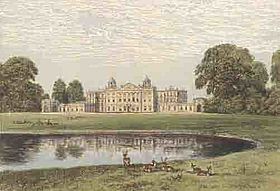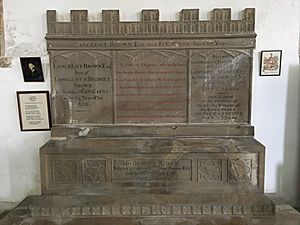Capability Brown facts for kids
Quick facts for kids
Lancelot "Capability" Brown
|
|
|---|---|
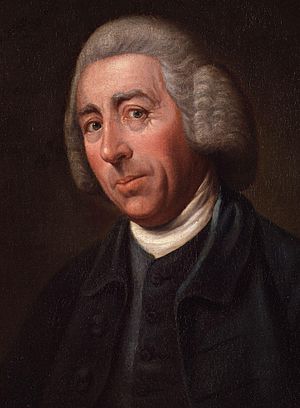
A portrait painting of Brown painted by Nathaniel Dance, c. 1773
|
|
| Born |
Lancelot Brown
Kirkharle, Northumberland, England
|
| Baptised | 30 August 1716 |
| Died | 6 February 1783 (aged 67–68) London, England
|
| Occupation | |
| Spouse(s) |
Bridget Wayet
(m. 1744) |
| Children | 8 |
| Parent(s) |
|
Lancelot Brown (born around 1715–16, baptised 30 August 1716 – died 6 February 1783), was an English gardener and landscape architect. He is best known as Capability Brown. He is the most famous person in the history of the English landscape garden style. Many people call him "England's greatest gardener."
Unlike other designers, Brown was very hands-on. He offered a complete service to his clients. He would design the gardens and parks, then manage all the planting and landscaping work. He is most famous for the beautiful parks around large English country houses. Many of these parks still exist today.
Brown also designed "pleasure gardens" with flowers and new shrubberies. These were usually placed where they would not block the main views of the house. Most of these smaller gardens have changed over time. He also worked on smaller city projects, like college gardens in Cambridge.
Some people criticised his style. They said he made all landscapes look too similar. They felt he used too much open grass, some water, and groups of trees. This made his designs seem a bit unoriginal to some. However, his influence was huge. He designed over 170 parks. He got his nickname "Capability" because he would tell clients their land had "capability" for improvement.
Contents
Brown's Early Life and First Big Job
Lancelot Brown was the fifth child in his family. His father managed land, and his mother was a maid. He was born in Kirkharle, Northumberland, England. He went to school in Cambo until he was 16. His father worked for Sir William Loraine, and his mother worked at Kirkharle Hall.
After school, Lancelot became an apprentice gardener. He worked in the kitchen garden at Sir William Loraine's estate until he was 23. In 1739, he travelled south to Boston. Then he moved inland. His first landscape job was to create a new lake at Kiddington Hall, Oxfordshire. Later, he moved to Wotton Underwood House in Buckinghamshire.

In 1741, Brown joined the gardening team at Stowe Gardens, Buckinghamshire. He worked under William Kent, who helped start the new English style of landscape gardens. By 1742, at age 26, Brown became the Head Gardener. He earned £25 a year and lived in a special house on the estate.
Brown stayed at Stowe until 1750. He helped create the Grecian Valley there, working with William Kent. This area was a mix of land shapes and trees. Lord Cobham, the owner of Stowe, allowed Brown to take on other jobs for his friends. This helped Brown become well-known as a landscape gardener. Soon, wealthy families wanted his designs.
By the 1760s, Brown was earning a lot of money. He usually got £500 for one project. He was a skilled horse rider and could survey an estate quickly. He could plan a whole design in about an hour. In 1764, King George III made Brown his Master Gardener at Hampton Court Palace. Brown bought his own estate in Fenstanton in 1767. He was even appointed High Sheriff of Cambridgeshire and Huntingdonshire in 1770.
Brown's Famous Landscape Gardens
It is believed that Brown designed over 170 gardens. These were for the most beautiful country houses and estates in Britain. You can still see his work at places like Belvoir Castle, Croome Park, Blenheim Palace, and Warwick Castle. You can also find traces of his work at Kew Gardens.
His style used smooth, rolling grass that went right up to the house. He planted groups of trees and long lines of trees. He also created winding lakes by cleverly damming small rivers. This was a new style of landscape gardening. It got rid of the older, more formal garden designs.
Brown's landscapes were very fashionable. They were different from the formal gardens that were popular before. Starting in 1719, William Kent began to create more natural-looking gardens. Brown then perfected this natural style.
At Hampton Court, Brown met Hannah More in 1782. She described his design method like grammar: "Now there", he would say, pointing, "I make a comma. And there," pointing again, "where a more decided turn is proper, I make a colon." He would even make a "parenthesis" to break the view.
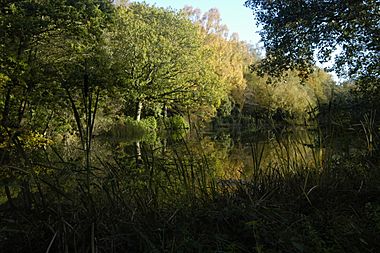
What People Thought of His Work
Some people criticised Brown's designs. Uvedale Price, a writer from Brown's time, said Brown's groups of trees looked like "so many puddings turned out of one common mould." This meant they looked too similar. Russell Page, another designer, said Brown encouraged rich clients to remove their beautiful formal gardens. He felt Brown replaced them with simple designs of grass, tree clumps, and shapeless lakes.
The poet Richard Owen Cambridge joked that he hoped to die before Brown. He wanted to "see heaven before it was 'improved'." This shows that Brown's work was often debated. However, others praised his skill. One writer said that Brown was so good at copying nature that his work would be mistaken for natural landscapes. In 1772, Sir William Chambers complained that the "new manner" of gardens looked too much like "common fields."
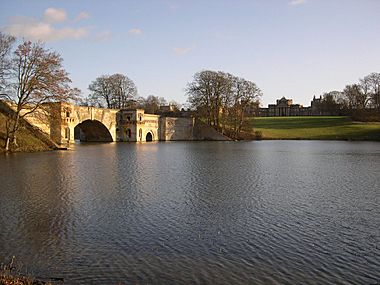
Brown's Architectural Work
Capability Brown also created over 100 architectural drawings. His work in architecture grew naturally from his ideas about designing a country house and its surroundings. He believed the house should be a part of the landscape, not just stand out from it.
Humphry Repton, another landscape designer, said Brown "fancied himself an architect." But Repton also added that Brown was excellent at planning comfortable and beautiful buildings. Brown's first country house project was redesigning Croome Court, Worcestershire, in 1751–52.
Brown designed buildings in different styles. Places like Fisherwick and Claremont were classical. But at Corsham, his smaller buildings were in a Gothic style, like the bathhouse. He often designed Gothic stable blocks, arches, and other decorative garden features. From 1771, he worked with master builder Henry Holland and his son, also named Henry Holland. The younger Henry Holland became Brown's full partner and later married Brown's daughter in 1773.
Brown's Legacy and Reputation
After Brown died, his reputation quickly went down. People felt his landscapes were too calm and lacked drama. The Romantic generation wanted landscapes that felt wild and powerful. They preferred the dramatic paintings of Salvator Rosa over the peaceful ones of Claude Lorrain.
Throughout the 1800s, he was widely criticised. But in the 1900s, his reputation improved again. Historians like Dorothy Stroud wrote books about his work, showing how important he was. Later landscape architects like William Gilpin argued that Brown's "natural curves" were just as artificial as the straight lines in French gardens.
Brown's portrait by Nathaniel Dance (around 1773) is in the National Portrait Gallery in London. His work is often compared to that of André Le Nôtre, the French landscape architect. Brown became very rich and respected. He "improved" more land than any landscape architect before him.
In 2016, a festival celebrated 300 years since Brown's birth. The Capability Brown Festival 2016 shared new research and held over 500 events. Royal Mail even released stamps in his honour. In 2017, a report called Vulnerability Brown looked at how to protect his landscapes. In 2018, a special fountain was dedicated to him in Westminster Abbey.
Brown's Family Life
On 22 November 1744, Lancelot Brown married Bridget Wayet, who he called Biddy. She was from Boston, Lincolnshire. Her father was a local official and landowner. They had eight children: Bridget (born 1746), Lancelot (called Lance), William (who died young), John (born 1751), another son who died young, Anne (born and died 1756), Margaret (called Peggy, born 1758), and Thomas (born 1761).
In 1768, he bought a large estate called Fenstanton in Huntingdonshire for £13,000. This estate included two manor houses, two villages, and over 2,600 acres of land. The property stayed in his family until the 1870s and 1880s. Owning this land allowed him to serve as High Sheriff of Huntingdonshire from 1770 to 1771.
Brown continued to work and travel until he died suddenly on 6 February 1783. He collapsed on the doorstep of his daughter Bridget Holland's house in London. He was returning from a night out with Lord Coventry.
Horace Walpole wrote about his death, saying: "Your dryads must go into black gloves, Madam, their father-in-law, Lady Nature’s second husband, is dead!" Brown was buried in the churchyard of St. Peter and St. Paul, the church for his Fenstanton estate. He left behind about £40,000. His eldest daughter, Bridget, married the architect Henry Holland. Brown sent two of his sons to Eton College. One son, Lancelot Brown the younger, became a Member of Parliament. His son John joined the Royal Navy and became an admiral.
Gardens and Parks Designed by Brown
Many of Capability Brown's parks and gardens are still open to the public today. Here is a partial list of the places he designed or worked on:
- Adderbury House, Oxfordshire
- Addington Place, Croydon
- Alnwick Castle, Northumberland
- Althorp, Northamptonshire
- Ampthill Park, Ampthill, Bedfordshire
- Ancaster House, Richmond, Surrey
- Appuldurcombe House, Isle of Wight
- Ashburnham Place, East Sussex
- Ashridge House, Hertfordshire
- Aske Hall, North Yorkshire
- Astrop Park, Northamptonshire
- Audley End, Essex
- Aynhoe Park, Northamptonshire
- The Backs, Cambridge
- Badminton House, Gloucestershire
- Ballyfin House, Ireland
- Basildon Park, Berkshire
- Battle Abbey, East Sussex
- Beaudesert, Staffordshire
- Beechwood, Bedfordshire
- Belhus, Essex
- Belvoir Castle, Leicestershire
- Benham, Berkshire
- Benwell Tower, near Newcastle upon Tyne
- Berrington Hall, Herefordshire
- Blenheim Palace, Oxfordshire
- Boarstall, Buckinghamshire
- Bowood House, Wiltshire
- Branches Park, Cowlinge, Suffolk
- Brentford, Ealing
- Brightling Park, Sussex
- Broadlands, Hampshire
- Brocklesby Park, Lincolnshire
- Burghley House, Lincolnshire
- Burton Constable Hall, East Riding of Yorkshire
- Burton Park, Sussex
- Burton Pynsent House, Somerset
- Byram, West Yorkshire
- Cadland, Hampshire
- Capheaton Hall, Northumberland
- Cardiff Castle, Cardiff
- Castle Ashby House, Northamptonshire
- Caversham, Berkshire
- Chalfont House, Buckinghamshire
- Charlecote, Warwickshire
- Charlton, Wiltshire
- Chatsworth, Derbyshire
- Chilham Castle, Kent
- Chillington Hall, West Midlands
- Church Stretton Old Rectory, Shropshire
- Clandon Park, Surrey
- Claremont, Surrey
- Clumber Park, Nottinghamshire
- Compton Verney, Warwickshire
- Coombe Abbey, Coventry
- Corsham Court, Wiltshire
- Croome Park, Worcestershire
- Dodington Park, Gloucestershire
- Danson Park, Bexley Borough of London
- Darley Abbey Park, Derby
- Ditchingham Hall, Ditchingham, Norfolk
- Euston Hall, Suffolk
- Farnborough Hall, Warwickshire
- Fawley Court, Oxfordshire
- Gatton Park, Surrey
- Grimsthorpe Castle, Lincolnshire
- Hampton Court Palace, Surrey
- Harewood House, Leeds
- Heveningham Hall, Suffolk
- Highclere Castle, Hampshire
- Highcliffe Castle, Dorset
- Himley Hall, Staffordshire
- Holkham Hall, Norfolk
- Holland Park, London
- The Hoo, Hertfordshire
- Hornby Castle, North Yorkshire
- Howsham, near York
- Ickworth, Suffolk
- Ingestre, Staffordshire
- Ingress Abbey, Kent
- Kelston, Somerset
- Kew Gardens, South West London
- Kiddington Hall, Oxfordshire
- Kimberley, Norfolk
- Kimbolton Castle, Cambridgeshire
- King's Weston House, Bristol
- Kirkharle, Northumberland
- Kirtlington, Oxfordshire
- Knowsley, near Liverpool
- Kyre Park, Herefordshire
- Lacock Abbey, Wiltshire
- Laleham Abbey, Surrey
- Langley, Berkshire
- Langley Park, Buckinghamshire
- Langley Park, Norfolk
- Latimer, Buckinghamshire
- Leeds Abbey, Kent
- Littlegrove, Barnet, London
- Lleweni Hall, Clwyd
- Longford Castle, Wiltshire
- Longleat, Wiltshire
- Lowther, Cumbria
- Luton Hoo, Bedfordshire
- Madingley Hall, Cambridgeshire
- Maiden Earley, Berkshire
- Mamhead House, Devon
- Melton Constable Hall, Norfolk
- Milton Abbey, Dorset
- Moccas Court, Herefordshire
- Moor Park, Rickmansworth, Hertfordshire
- Mount Clare, Roehampton, South West London
- Navestock, Essex
- Newnham Paddox, Warwickshire
- Newton Park, Newton St Loe, Somerset
- New Wardour Castle, Wiltshire
- North Cray Place, near Sidcup, Bexley, London
- North Stoneham Park, Eastleigh, Hampshire
- Nuneham Courtenay, Oxfordshire
- Oakley, Shropshire
- Packington Park, Warwickshire
- Paddenswick Manor, West London
- Patshull Hall, Staffordshire
- Paultons Park, Hampshire
- Peper Harow House, Surrey
- Peterborough House, Hammersmith, London
- Petworth House, West Sussex
- Pishiobury, Hertfordshire
- Porter's Park, Hertfordshire
- Prior Park, Somerset
- Ragley Hall, Warwickshire
- Redgrave Park, Suffolk
- Roche Abbey, South Yorkshire
- Sandleford, Berkshire
- Savernake Forest, Wiltshire
- Schloss Richmond (Richmond Palace) in Braunschweig, Germany
- Scampston Hall, North Yorkshire
- Sheffield Park Garden, Sussex
- Sherborne Castle, Dorset
- Sledmere House, East Riding of Yorkshire
- Southill Park, Bedfordshire
- South Stoneham House, Southampton, Hampshire
- Stoke Park, Buckinghamshire
- Stowe Landscape Garden
- Syon House, West London
- Temple Newsam, Leeds
- Thorndon Hall, Essex
- Trentham Gardens, Staffordshire
- Ugbrooke Park, Devon
- Wallington, Northumberland
- Warwick Castle, Warwick
- Wentworth Castle, South Yorkshire
- West Hill, Putney, South London
- Weston Park, Staffordshire
- Whitehall, London
- Whitley Beaumont, West Yorkshire
- Widdicombe Park, near Slapton, Devon
- Wimbledon House, South West London
- Wimbledon Park, South West London
- Wimpole Hall, Cambridgeshire
- Woburn Abbey, Bedfordshire
- Wolterton Hall, Norfolk
- Woodchester, Gloucestershire
- Woodside, Berkshire
- Wootton Place Rectory, Oxfordshire
- Wotton, Buckinghamshire
- Wrest Park, Bedfordshire
- Wrotham Park, Hertfordshire
- Wycombe Abbey, Buckinghamshire
- Wynnstay, Clwyd, Wales
- Youngsbury, Hertfordshire
More than 30 of these gardens are open for people to visit today.
See also
 In Spanish: Lancelot Brown para niños
In Spanish: Lancelot Brown para niños
- Ha-ha
- Landscape architecture


